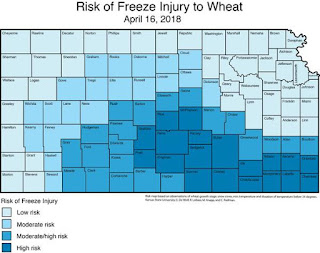But think about the rest of it: Wouldn't it be a sweet job to have room and board, health care and food provided for only a few months of work?
For all those fringe benefits, we do expect our herd bulls to do their job. That's why four of our bulls again went through a "job interview" last week with Dr. Dayul Dick from Prairie Vista Veterinary Hospital and Supply. (The fifth bull was the one we just purchased at Sandhill Farms production sale, so it had already been tested.)
Quality bulls are a big part of the beef business. It's a good management practice to test bulls before you turn them out into the pasture with the heifers and cows each spring. Bulls have no value if they can't perform. So Dr. Dick came to perform bull breeding soundness examinations.
First, Dr. Dick measured each bull's scrotum and examined it for defects.
He then needed to collect a semen sample using this contraption.
 He set up a mobile laboratory on the hood of a pickup, smearing a sample on a slide and looking through the microscope.
He set up a mobile laboratory on the hood of a pickup, smearing a sample on a slide and looking through the microscope. 
Then he smeared the slide with a dye, which killed the sperm. He could then look at morphology, the shape of the sperm. He was looking for abnormalities in the shape, which could indicate a problem with the ability to breed.
After the fertility tests, the bulls were each given vaccinations to keep them healthy during their summer in the pasture. It's similar to giving our children vaccinations for their optimal health.


That called for some creative acrobatics by both Liz and Dr. Dick to get the samples they needed, as well as a strategically-placed steel pipe to keep the bull in position.
The bulls aren't the only factor in the "birds and bees" of a Kansas cattleman.
The heifers who will become first-time mothers next winter also have been getting some extra care.
Beginning in March, our 25 yearling heifers had their silage topped with MGA. MGA is melengestrol acetate, which suppresses the ovulation cycle for the heifers. For 14 days, Randy added the MGA to the silage and fed the equivalent of 1/2 a pound per head per day.
This is the first step in getting the heifers to come into estrus (or heat) at the same time. These young ladies were born in early 2017. In 2019, they will become mothers for the first time.
On Monday, we sent the heifers through the working chute for the next phase of their OB-GYN appointments.
There, they each got a shot of Lutalyse, which makes the heifers come into heat.

Then it was time for the "birds and bees" to happen. The heifers were put in a pen with the bulls.
Some 283 days later,
the babies are supposed to arrive. So we will expect to get our first 80-pound bundles of joy next January 28 or so.
The bulls are ready. The heifers are ready. And if all goes as planned, the miracle of life begins yet again on the County Line.




















































